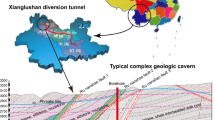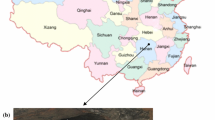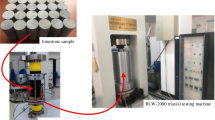Abstract
The hydro-mechanical coupling often leads to both mechanical properties and stability deterioration during excavation of water-rich tunnel rock mass. Deformation and mechanical, fracture, and strain energy characteristics of limestone from Maixi tunnel in Guiyang (China) are investigated by hydro-mechanical coupling tests in this paper. Results show that the water pressure has a significant influence on the stress-strain curve, strength characteristics, and macro-fracture degree. The compaction stage is relatively prolonged and elastic phase is shortened. With increasing water pressure, average peak strength decreases exponentially and both average elastic modulus and deformation modulus decrease linearly. The larger the water pressure, the better the fragment uniformity, and fragment uniformity increases exponentially but decreases logarithmically with peak strength. Mercury-injection curve shows a rapid increase then develops gently; the pore volume per unit mass increases exponentially revealing that water pressure has a significant effect on the dissolution pores. Strain energy dissipation characteristics show that total strain energy, dissipation strain energy, and releasable strain energy decrease exponentially with increasing water pressure. Energy ratio Ud/Ut experiences a slow increase, then dramatic rise, and finally develops gently, but Ue/Ut goes through a negative development tend and its boundary points of water pressure are both 2 MPa and 4 MPa. Ud/Ut has a typical logistic function with water pressure reflecting the damage degree and sensitivity of dissipation strain energy to water pressure.















Similar content being viewed by others
References
Atkinson BK, Meredith PG (1981) Stress corrosion cracking of quartz: a note on the influence of chemical environment. Tectonophysics 77(1-2):1–11
Chai B, Tong J, Jiang B, Yin KL (2014) How does the water-rock interaction of marly rocks affect its mechanical properties in the Three Gorges reservoir area, China. Environ Earth Sci 72(8):2797–2810
Chang SH, Lee CI (2004) Estimation of cracking and damage mechanisms in rock under triaxial compression by moment tensor analysis of acoustic emission. Int J Rock Mech Min Sci 41(7):1069–1086
Ciantia MO, Prisco C (2016) Extension of plasticity theory to debonding, grain dissolution, and chemical damage of calcarenites. Int J Numer Anal Met 40(3):315–343
Cyril G, Yves-henri F, Remi B, Chia-chun H (2010) Contact erosion at the interface between granular coarse soil and various base soils under tangential flow condition. J Geotech Geoenviron 136(5):741–750
Feucht LJ, Logan JM (1990) Effects of chemically active solutions on shearing behavior of sandstone. Tectonophysics 175(1):159–176
Huang D, Huang RQ, Zhang YX (2012) Experimental investigations on static loading rate effects on mechanical properties and energy mechanism of coarse crystal grain marble under uniaxial compression. Chin J Rock Mech Eng 31(2):245–255
Huo RK, Li SG, Han F, Wang GJ (2018) CT analysis on mesoscopic structure of sandstone under acidic environment. Indian J Mar Sci 47(5):962–971
Ishida T (2001) Acoustic emission monitoring of hydraulic fracturing in laboratory and field. Constr Build Mater 15(5):283–295
Kachanov LM (1999) Rupture time under creep conditions. Int J Fract 97(1-4):11–18
Korneva I, Tondi E, Rustichelli A, Mitchell TM, Agosta F (2013) Mechanical and chemical processes in the fault zone crosscutting slope Apulian carbonate platform and their effect on the fault permeability (Gargano Promontory, Italy). AGU Fall Meeting Abstracts
Li YY, Zhang SC, Zhang X (2018) Classification and fractal characteristics of coal rock fragments under uniaxial cyclic loading conditions. Arab J Geosci 11(9). https://doi.org/10.1007/s12517-018-3534-2
Mangold DC, Tsang C (1991) A summary of subsurface hydrological and hydro-chemical models. Rev Geophys 29(1):51–79
Masuda K (2001) Effects of water on rock strength in a brittle regime. J Struct Geol 23(11):1653–1657
Mccutcheon AL, Kannangara GSK, Wilson MA, Nissan BB (2004) Preliminary analysis of pore distributions using NMR in natural coral and hydrothermally prepared hydroxyapatite. J Mater Sci 39(18):5711–5717
Mu K, Yu J, Li H, Li H, Chen X (2015) Acoustic emission of sandstone with hydro-mechanical coupling and PFC-based modelling of energy dissipation. Rock Soil Mech 36(05):1496–1504
Nasseri MHB, Young RP, Su X, Nguyen TS, Li Z (2018) Hydro-mechanical behaviour of the Cobourg limestone. Int J Rock Mech Min 102:42–51
Putnis A, Mauthe G (2010) The effect of pore size on cementation in porous rocks. Geofluids 1(1):37–41
Rutqvist J (2015) Fractured rock stress-permeability relationships from in situ data and effects of temperature and chemical-mechanical couplings. Geofluids 15(1-2):48–66
Schulze O, Popp T, Kern H (2001) Development of damage and permeability in deforming rock salt. Eng Geol 61(2):163–180
Song ZP, Yang TT, Jiang AN, Zhang DF, Jiang ZB (2016) Experimental investigation and numerical simulation of surrounding rock creep for deep mining tunnels. J S Afr Inst Min Metall 116(12):1181–1188
Song ZP, Cheng Y, Yang TT, Huo RK, Wang JB, Liu XR (2019a) Experimental study on the influence of osmotic pressure on pore structure evolution of limestone. Rock Soil Mech 40(12):4607–4619,4643
Song ZP, Mao JC, Tian XX, Zhang YW, Wang JB (2019b) Optimization analysis of controlled blasting for passing through houses at close range in super-large section tunnels. Shock Vib 1–17. https://doi.org/10.1155/2019/1941436
Song ZP, Shi GL, Wang JB, Wei HM, Wang T, Zhou GN (2019c) Research on management and application of tunnel engineering based on BIM technology. J Civ Eng Manag 25(8):785–797
Song ZP, Tian XX, Zhang YW (2019d) A new modified peck formula for predicting the surface settlement based on stochastic medium theory. Adv Civil Eng 1–14. https://doi.org/10.1155/2019/7328190
Song ZP, Shi GL, Zhao BY, Zhao KM, Wang JB (2019e) Study of the stability of tunnel construction based on double-heading advance construction method. Adv Mech Eng 11(12):1–17. https://doi.org/10.1177/1687814019896964
Vásárhelyi B, Ván P (2006) Influence of water content on the strength of rock. Eng Geol 84(1-2):70–74
Wang JA, Park HD (2002) Fluid permeability of sedimentary rocks in a complete stress-strain process. Eng Geol 63(3):291–300
Wang LX, Xu SS, Qiu JL, Wang K, Ma EL, Li CH, Guo CX (2020) Automatic monitoring system in underground engineering construction: review and prospect. Adv Civil Eng:1–14. https://doi.org/10.1155/2020/3697253
Wu K, Shao ZS, Qin S, Li BX (2019) Determination of deformation mechanism and countermeasures in silty clay tunnel. J Perform Constr Facil 34:04019095. https://doi.org/10.1061/(ASCE)CF.1943-5509.0001381
Yashwanth C, Camilo M, Carl S, Chandra R (2013) An experimental investigation into hydraulic fracture propagation under different applied stresses in tight sands using acoustic emissions. J Pet Sci Eng 108(3):151–161
Yasuhara H, Elsworth D, Polak A, Liu JS, Grader A, Halleck P (2006) Spontaneous switching between permeability enhancement and degradation in fractures in carbonate: lumped parameter representation of mechanically-and chemically-mediated dissolution. Transp Porous Med 65(3):385–409
Yu J, Li H, Chen X, Wu N, Mu K (2013) Triaxial experimental study on sandstone of the permeability-strain relationship under coupling effects of seepage and stress. China Rock Mech Eng 32(6):1203–1213
Zhang L, Huang G, Luo JY, Zhang X (2018) A surrounding rock stress distribution model for deep mining. Indian J Mar Sci 47(12):2407–2414
Zhao YL, Tang JZ, Chen Y, Zhang LY, Wang WJ, Wan W, Liao JP (2017) Hydromechanical coupling tests for mechanical and permeability characteristics of fractured limestone in complete stress-strain process. Environ Earth Sci 76(1):24–42
Zhu WC, Bmhns OT (2008) Simulating excavation damaged zone around a circular opening under hydro mechanical conditions. Int J Rock Mech Min Sci 45(5):815–830
Acknowledgments
We thank the reviewers and editors for their comments and suggestions for the manuscript.
Funding
This work was financially supported by the National Natural Science Foundation of China (Grant No. 51578447) and Natural Science Basic Research Program of Shaanxi (2019JQ-762) and Project funded by China Postdoctoral Science Foundation (2018M643809XB) and Project Foundation of Department of Housing and Urban Rural Development of Shaanxi Province (2019-K39).
Author information
Authors and Affiliations
Contributions
Prof. Zhanping Song conceived the experiments and edited the paper. Dr. Yun Cheng and Tengtian Yang tested the data and wrote the article. Prof. Junbao Wang guided the implementation of experiments and edited the paper. Dr. Xiaoxu Tian provided the rock samples and tested the data.
Corresponding authors
Ethics declarations
Conflict of interest
The authors declare that they have no conflict of interest.
Additional information
Responsible editor: Zeynal Abiddin Erguler
Rights and permissions
About this article
Cite this article
Song, Z., Cheng, Y., Tian, X. et al. Mechanical properties of limestone from Maixi tunnel under hydro-mechanical coupling. Arab J Geosci 13, 402 (2020). https://doi.org/10.1007/s12517-020-05373-z
Received:
Accepted:
Published:
DOI: https://doi.org/10.1007/s12517-020-05373-z




